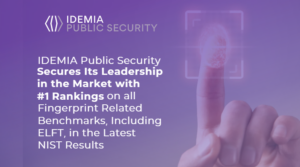
Gaurav Gupta, Sales Director for Public Security & Identity, ASEAN, IDEMIA,
explores how countries can make travel safer with contactless technology and data.
Checking in, going through security, and boarding a flight without once removing your physical passport from your backpack – this is what the future of travel could look like. As borders reopen, countries are looking for new ways to improve border security and
efficiency.
"We need to put that confidence back into the travellers that they can safely travel. Digital passports, biometrics and automation will be key, he believes. Border control measures will also need to focus on health and sanitation while maintaining security."
Gaurav Gupta, Sales Director for Public Security & Identity, ASEAN, IDEMIA
Gupta shares how contactless biometric technology and data analytics can improve the screening and border clearance process when travelling post-pandemic.
Contactless travel during Covid
Covid-19 has accelerated the adoption of contactless technology in airports, says Gupta. This helps to prevent contamination and minimise the spread of the
virus by reducing physical interaction between passengers and airport staff, he explains.
There are three types of biometric tech that are promising. The first is face recognition.
ADP Group and French airline company Transavia have introduced face recognition for passengers at Paris Orly Airport from check-in to boarding. Singapore’s Changi Airport has also implemented face capture to give passengers a frictionless experience all the way
through to border control.
The second type of contactless verification involves iris scanners. Passengers typically have to stand really close to traditional scanners, but IDEMIA has developed a more advanced tool.
The improved tech works even when passengers look at the device from a distance while still in motion. This means that passengers do not need to stop while
getting identified, says Gupta.
Third is touchless fingerprint sensors, Gupta shares. Traditional fingerprint sensors can only capture fingerprints when passengers press their fingers down
on a screen.
These new touchless fingerprint sensors contain high definition cameras that can capture fingerprints with a wave of the hand, without any compromise on accuracy. “It’s a much faster process and provides contactles experience to the passenger,” he notes.
Health risk profiling
Biometrics are important, but border authorities need to consider the complete concept of operations for border clearance as well, says Gupta. For example, gathering information in advance can create a more effective clearance process, he adds.
Governments have started checking travellers’ health-related information to determine whether they may enter the country. Information such as recent travel history, Covid-19 test results, and vaccination status helps authorities identify risky profiles.
Border control agencies can combine this health data with other forms of travel data, including passenger travel authorisations, to make better decisions, he shares.
However, it can be tricky for border control authorities to validate health information. There is no international standard for implementing health and vaccine certificates yet. A vaccine certificate issued by one country, for example, may not be recognised by
another country.
To address this problem, IDEMIA developed an interoperable health travel pass which helps governments verify the health status of incoming travellers before they begin their journey, says Gupta.
With the health travel pass, travellers can upload their health information beforehand, whether they are digital or paper-based. This information will be authenticated and verified though an IDEMIA tool to ensure that all elements required by the destination
country are present.
They will then follow entry-exit rules of destination country on whether to admit the traveller into the country.
Balancing privacy and efficiency
Biometrics often brings with it sticky privacy concerns, since the information is incredibly sensitive. But passengers shared that they are willing to share biometric data and immigration information if it does improve border clearance processes, according to the
International Air Transport Association’s 2021 Global Passenger Survey.
12 million US passengers have already enrolled in the TSA PreCheck US Programme, which allows low risk travellers to go through a faster security screening process with biometrics, Gupta shares.
“Passengers need to have a clear understanding about the purpose of the usage of their biometric data,” he says. While biometric technology has great potential to increase convenience, it still needs to be done in an ethical and secure way, he continues.
Citizens need to know when their biometric data has been captured, how long, and what it will be used for, he says. The overall IT security is important for any large-scale identity-related programmes that include biometrics, Gupta continues.
Data should be stored behind strong encryption protocols. For instance, biometric data should be stored such that it cannot be decrypted even if leaked, he explains. Additionally, organisations managing biometric data need to comply with local guidelines and regulations to establish trust, he adds.
With citizens’ trust, organisations will have access to more data and be able to create better technology, further improving the border clearance process. With a combination of data and technology, the future of travel may become quick, easy, and completely
automated, while still maintaining respect of privacy and rigorous security standards.



